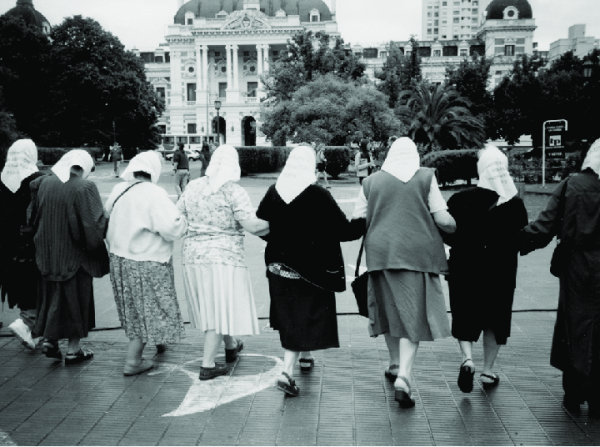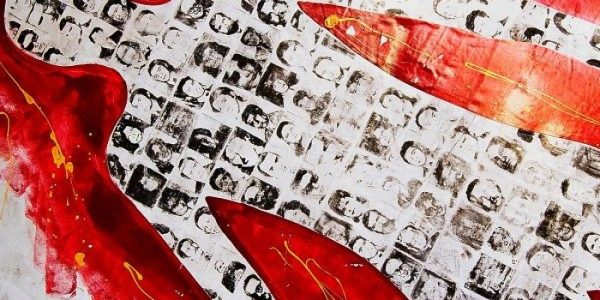Article and translation by Jessica Nevo
Every year, on March 24, 2024, we Argentinians marked 48 years since the last military coup. On this day in 1976, the last dictatorship, the most murderous of all its predecessors, officially started. The last one with the help of Goddess.
It is estimated that between 1976 and 1983 the junta murdered around 30,000 women and men, most of whom were first held in 380 illegal detention centers where they were tortured. Some of them were then thrown, drugged, from airplanes into the La Plata River (I refer you to the episodes on Argentina in the "Beyond Justice" podcast).
Last December 10 marked the 40th anniversary of Argentina's return to democracy. Forty years of continuous democratic rule! This can not be taken for granted in Argentina: Of the 16 years I lived there, from the day I was born until my immigration to Israel, only two years were under democratic rule.
For anyone who breathes totalitarianism and knows the early signs of it, the attempt at a judicial coup in Israel last year, was a prolonged and extremely disturbing collection of frightening reminders of a regime that rules via self-censorship, curfews, hiding books and more.
Repeating History
Even so, we could not imagine what the traumatized souls of Argentines would encounter in the events of October 7: Murder and disappearance of civilians into Gaza and prolonged captivity in private homes and facilities throughout the strip.
The capture and disappearance of women, men and children into Gaza on October 7th is an extreme and difficult re-victimization for anyone who lived under the dictatorships in Chile, Uruguay and Argentina. Also in Mexico, Colombia, Guatemala and other countries, women know what it means to have your neighbors, colleagues, friends and members of your immediate family kidnapped from their homes never to be seen again. The disappeared cannot be traced, visited, nor can be saved by the army.
The signs with the faces of the kidnapped that appeared on the walls of buildings on Kaplan Street, when Avihai Brodetzbegan demonstrating for the release of his wife, three children and their little neighbor Abigail, resonate with us survivors of the dictatorship in Argentina. The signs echo the brave women, the mothers and grandmother, who came with their children's photos to May Square in Buenos Aires in April 1977 to ask "Where have our children gone?". These women continued to demonstrate every week, in the square in front of the governmental palace – La Casa Rosada, with white handkerchiefs on their heads – a tribute to the diapers of the children who were disappeared by the regime.

Sexual Violence in Captivity
Under the dictatorship it was forbidden to demonstrate, of course. An incidental gathering of 3-4 women on a street corner was considered an "illegal gathering" that could put you at risk of arrest, of kidnapping. Some of the mothers of the disappeared were, indeed, kidnapped and murdered themselves.
Reports of sexual violation of women by Hamas on Oct. 7,prompted intense discussions on social media and among feminist organizations about other contexts of rape during conflicts and wars. Comparisons were made with the planned collective attacks, as part of civil wars in Rwanda (1994) and Yugoslavia (1990).
But beyond the events of Oct. 7th, we must ask what is happening in the present to the women held captive by a violent organization? Argentina is a case study that is important to consider.
The prolonged stay of women (and men) in captivity in Gaza, in private homes, facilities and tunnels in Gaza, chillingly echoes what women and men, who were kidnapped and imprisoned throughout Argentina, went through. In most of these detention centers, the captives and the prisoners lived together. We learned of their experiences from the around 2,000 men and women survivors.
In 1984, women who survived captivity in the Argentine dictatorship recounted their experiences of gender-based violence, as an integral part of their torture and other abuse they had survived. While already in 1985 Argentine military men and women began to be tried for crimes against humanity and gender crimes, with sexual assault being the last legal category that received recognition in the legal processes.
Only in recent years has gender-based violence received distinct and independent classification in the legal statues regarding combat situations. While already in 1985, Argentine military women and men began to be prosecuted for crimes against humanity, gender crimes were the last legal category that received recognition in the legal processes. The proceedings are still ongoing against the criminals. This legal development reveals a long and painful process of women who survive detention facilities and "former disappeared", who after 25 years from the end of the dictatorship (1983) dared break the silence.

Transitional Justice
The testimonies of female survivors in Argentina have changed over time. The ability of these women captives first to speak among themselves, and later speak publicly about the gender and sexual aspects of their captivity, is the result of a long journey. This also reveals how the communities in Argentina dealt with the past, with the demand for structural changes and the prosecution of the criminals, practices that were innovative and helped shape today’s model of what is known as ‘transitional justice’, a set of practices that emerged after the WWII and gained momentum with the end of the Junta in Greece (1975).
At the early stages of this journey were the efforts of civil society organizations, mainly of lawyers and psychologists, who facilitated the ‘translation’ of the experiences of survivors of captivity into legal testimonies. The main goal at this initial stage was to provide proof of the existence of a systemic program of oppression through:
- Gathering information from POWs in order to understand what happened to them: who saw who, where people were transferred, when was the last time you saw them, who was with you in the same cell/house/camp, etc, To challenge attempts by the military to present the crimes as isolated cases and "bad apples".
- Establish the legal term of "disappeared”" ("desaparecido"), to describe a man or a woman who were detained never to be seen again. This concept was at the center of the efforts of the activists and the activity.
These testimonies formed a significant basis for the "National Commission to Investigate the Disappearance of Persons" (1984, CONADEP), and the first prosecutions of the junta's people for crimes against humanity (Case 13/84- 1985). The efforts spent to reveal and prove the existence of the "Great Plan" came at the expense of personal experiences. Both in the discussions at CONADEP and in the trials themselves, a systematic set of tortures in the illegal detention centers was revealed, including subhuman living conditions for women, sexual abuse/gender-based crimes and different punishments for women and men. When mentioned by women who testified, judges often silenced witnesses when they started talking about gender crimes and asked them to focus on the main thing – the torture.
Pressures on the new government and a failed military coup attempt, in 1987, led to legislation that granted immunity to untried military personnel, and freed 1,200 already convicted of crimes against humanity, including those sentenced to life imprisonment. But the cancellation of the immunity and amnesty laws in the early 2000s (2001-2006), ushered in a new wave of prosecutions, with a new acceptance of personal stories, including the abuse of women. The attacks against women were presented for the first time not as isolated incidents, but as part of a systematic plan and as part of torture. Now attempts by judges and defense teams of the criminals to insist there was insufficient "evidence" to prove harm against women were unsuccessful. As in the context of child abuse by parents, in sects-cults, in women abused by their partners, in prostitution, the argument that testimonies without physical evidence became no longer relevant. Testimony is what there is. This is the essence of the crimes.
With the 48th anniversary of the rise of dictatorial rule in Argentina, I stop and shout that the women and men who were kidnapped, are still captive in Gaza, going on 6 months! The Argentinian test case gives us an opportunity to prepare the ground for the long-awaited day after the captivity: learning from the trial processes, collecting the evidence, bringing justice and rehabilitation. This knowledge may help communities, professionals, family members and the survivors themselves.
Out of the struggle for the release of the women and men in captivity, the Tribunal on Gender Crimes invites professionals in Israel to be inspired and learn from colleagues in Argentina how to create a sensitive protocol for the return of the women captives, as a model for collecting testimony, and a documentation mechanism. Let's learn from the experience of the women who survived the captivity in Argentina and thus also facilitate the process for doing justice.
Jessica Nevo. Sociologist, Independent researcher of transitional justice. Founder of the "Tribunal-Alternative Justice for Women and Gender. "Graduated" from Argentina’s dictaduras.
Thanks to Aya Arbel Sharif for advice and editing and to Mariana Wikinski.
To join the establishment of a system adapted to women after a long imprisonment: tribunal.nashim@gmail.com www.tribunal.org.il






תגובה אחת
Usually I do not read article on blogs however I would like to say that this writeup very compelled me to take a look at and do it Your writing style has been amazed me Thank you very nice article